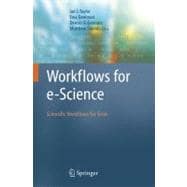
Note: Supplemental materials are not guaranteed with Rental or Used book purchases.
Purchase Benefits
What is included with this book?
| Foreword | p. vii |
| List of Contributors | p. xiii |
| Introduction | p. 1 |
| Scientific versus Business Workflows | p. 9 |
| Application and User Perspective | |
| Generating Complex Astronomy Workflows | p. 19 |
| A Case Study on the Use of Workflow Technologies for Scientific Analysis: Gravitational Wave Data Analysis | p. 39 |
| Workflows in Pulsar Astronomy | p. 60 |
| Workflow and Biodiversity e-Science | p. 80 |
| Ecological Niche Modeling Using the Kepler Workflow System | p. 91 |
| Case Studies on the Use of Workflow Technologies for Scientific Analysis: The Biomedical Informatics Research Network and the Telescience Project | p. 109 |
| Dynamic, Adaptive Workflows for Mesoscale Meteorology | p. 126 |
| SCEC CyberShake Workflows-Automating Probabilistic Seismic Hazard Analysis Calculations | p. 143 |
| Workflow Representation and Common Structure | |
| Control- Versus Data-Driven Workflows | p. 167 |
| Component Architectures and Services: From Application Construction to Scientific Workflows | p. 174 |
| Petri Nets | p. 190 |
| Adapting BPEL to Scientific Workflows | p. 208 |
| Protocol-Based Integration Using SSDL and [pi]-Calculus | p. 227 |
| Workflow Composition: Semantic Representations for Flexible Automation | p. 244 |
| Virtual Data Language: A Typed Workflow Notation for Diversely Structured Scientific Data | p. 258 |
| Frameworks and Tools: Workflow Generation, Refinement, and Execution | |
| Workflow-Level Parametric Study Support by MOTEUR and the P-GRADE Portal | p. 279 |
| Taverna/[superscript my]Grid: Aligning a Workflow System with the Life Sciences Community | p. 300 |
| The Triana Workflow Environment: Architecture and Applications | p. 320 |
| Java CoG Kit Workflow | p. 340 |
| Workflow Management in Condor | p. 357 |
| Pegasus: Mapping Large-Scale Workflows to Distributed Resources | p. 376 |
| ICENI | p. 395 |
| Expressing Workflow in the Cactus Framework | p. 416 |
| Sedna: A BPEL-Based Environment for Visual Scientific Workflow Modeling | p. 428 |
| ASKALON: A Development and Grid Computing Environment for Scientific Workflows | p. 450 |
| Future Requirements | |
| Looking into the Future of Workflows: The Challenges Ahead | p. 475 |
| References | p. 483 |
| Index | p. 514 |
| Table of Contents provided by Ingram. All Rights Reserved. |
The New copy of this book will include any supplemental materials advertised. Please check the title of the book to determine if it should include any access cards, study guides, lab manuals, CDs, etc.
The Used, Rental and eBook copies of this book are not guaranteed to include any supplemental materials. Typically, only the book itself is included. This is true even if the title states it includes any access cards, study guides, lab manuals, CDs, etc.